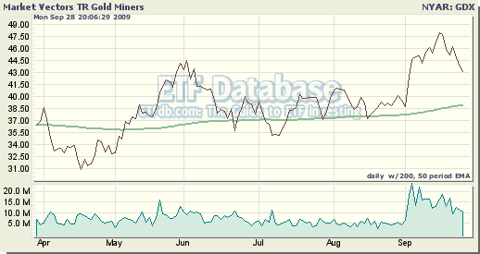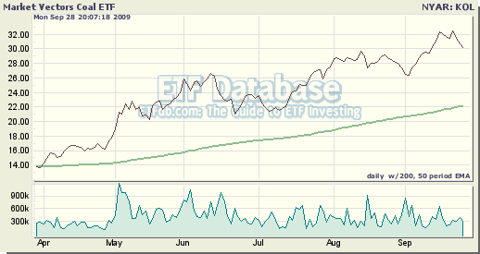Tuesday, September 29, 2009 2:50:23 AM
September 29, 2009
When they were introduced several years ago, exchange-traded commodity products were hailed as a major breakthrough, offering average investors easy, cost efficient exposure to an asset class that had previously been accessible primarily through futures markets and physical storage of natural resources, both of which are beyond the reach of many investors (see our complete guide to ETFs for Very High Net Worth Individuals here).
How times have changed.
Exchange-traded commodity products are now the subject of intense scrutiny from a number of parties, with regulators cracking down on funds that have grown so significantly that they now represent a significant portion of all outstanding futures contracts on certain commodities. The United States Natural Gas Fund (UNG) was forced to halt new share creations earlier this year, and Deutsche Bank recently announced the shuttering of the PowerShares DB Crude Oil Double Long ETN (DXO), the first, but probably not the last, fund to close as a result of an evolving regulatory environment.
It’s likely that ETF sponsors will in turn adapt to position limits and other restrictions enacted by the CFTC and other regulatory agencies later this year. Several have already come up with a simple but effective solution: a commodities fund that doesn’t own either commodities or commodities futures.
The latest ETF to use this strategy is the Thomson-Reuters Jefferies Commodity Equity Index Fund (CRBQ), which invests in companies that produce commodities, such as miners of precious metals and oil drilling firms. Because the holdings of the ETF are equities, CRBQ doesn’t risk running afoul of existing or upcoming position limits on futures contracts, a major concern for many funds at present.
The weightings of individual companies in the ETF are determined not by market capitalization, but by the market value of the resources produced. Energy companies, including ExxonMobil (XOM), BP plc (BP), OAO Gazprom (OGZYPY.PK), Total SA (TOT), Petroleo Brasileiro (PBR), and Royal Dutch Shell (RDS.A), account for nearly 40% of CRBQ’s holdings. U.S. and Canadian equities account for about half of this ETF’s holdings, with the remaining half spread across a handful of resource-heavy economies, including Australia, Brazil, and South Africa.
CRBQ isn’t the first ETF sponsor to use this approach. Van Eck has a line of “hard asset ETFs” that invest in equities of firms involved in various commodity businesses, including:
Gold Miners (GDX)
Hard Assets Producers (HAP)
Agribusiness (MOO)
Coal (KOL)
Steel (SLX)
PowerShares has also jumped into this space, offering the Global Coal Portfolio (PKOL).
While these strategies avoid troublesome futures contracts and expenses associated with physically storing commodities, investors hoping for strong correlations with spot prices may be disappointed (or very pleasantly surprised, depending on the direction of the commodities markets). The SPDR Gold Trust (GLD) has gained about 12% this year as investors have flocked to safe havens.
Over the same period, the Market Vectors Gold Miners ETF (GDX), which invests in companies that derive their revenues from mining activities, has gained about 27%, or more than twice the increase in the spot price of gold. Because many commodity producers have significant fixed costs, increases in the prices of underlying resources may fall straight to the bottom line.

Even more severe is the relationship between coal prices and the performance of two coal ETFs so far in 2009. KOL and PKOL, which both invest in companies that derive their revenue from the coal industry, have delivered returns of 105.5% and 97.2%, respectively, so far in 2009, while coal prices have actually declined. According to the Energy Information Administration, the price of Central Appalachia 12,500 BTU coal has dropped by about 31% since the beginning of 2009.

While the prices of commodities in which these companies deal certainly has a major impact on firm and industry profitability, it isn’t the only factor that drives prices. After all, these “indirect commodity ETFs” are still comprised of equities, not commodities. Because they maintain exposure to commodity prices but also domestic and international equity markets, these funds have a number of potential uses in portfolios, ranging from hedges against inflation to speculation in commodity prices.
VHAI - Vocodia Partners with Leading Political Super PACs to Revolutionize Fundraising Efforts • VHAI • Sep 19, 2024 11:48 AM
Dear Cashmere Group Holding Co. AKA Swifty Global Signs Binding Letter of Intent to be Acquired by Signing Day Sports • DRCR • Sep 19, 2024 10:26 AM
HealthLynked Launches Virtual Urgent Care Through Partnership with Lyric Health. • HLYK • Sep 19, 2024 8:00 AM
Element79 Gold Corp. Appoints Kevin Arias as Advisor to the Board of Directors, Strengthening Strategic Leadership • ELMGF • Sep 18, 2024 10:29 AM
Mawson Finland Limited Further Expands the Known Mineralized Zones at Rajapalot: Palokas step-out drills 7 metres @ 9.1 g/t gold & 706 ppm cobalt • MFL • Sep 17, 2024 9:02 AM
PickleJar Announces Integration With OptCulture to Deliver Holistic Fan Experiences at Venue Point of Sale • PKLE • Sep 17, 2024 8:00 AM






